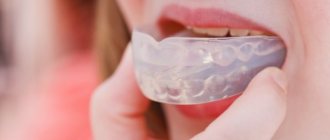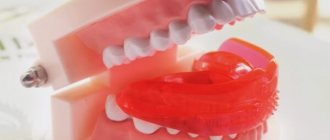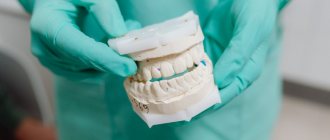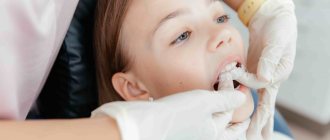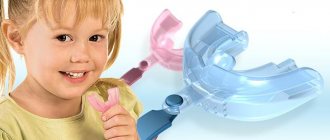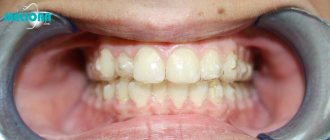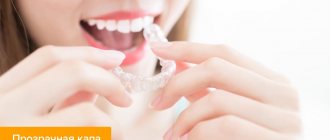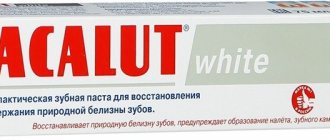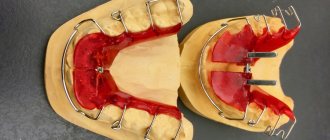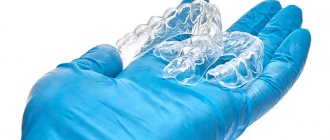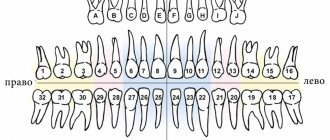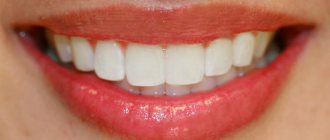Dental trainers are a type of myofunctional correctors that are used to correct bites along with classic plates and brace systems that are already familiar to everyone. The main feature of trainers is that they not only remove the consequences - they correct incorrectly formed teeth, but work with the cause: they help develop the jaw muscles, remove excess pressure on the bones, form correct nasal breathing, and tongue position. That is why this method of treatment is considered more promising.
Indications for the use of dental trainers
A dental trainer is usually prescribed to be worn in the following situations:
- a person cannot have braces installed for one reason or another;
- the bite has formed incorrectly;
- swallowing is impaired;
- teeth are displaced;
- often stuffy nose due to problems in the oral cavity;
- complexes or profession do not allow wearing other systems;
- there are speech therapy problems, etc.
Sometimes, if a doctor sees that a patient is at risk of malocclusion, he will prescribe a dental trainer as a preventive measure.
Read in detail about problems with bite here: All about bite: what it is like
General information and purpose
The TMJ splint is a rigid, removable, thermo-modeling device that is worn like a mouthguard on one of the jaws.
The device is intended for intraoral use in adult patients. The design and construction were developed using a computer system. Supplied with preset parameters.
The splint is of great importance for doctors, as it allows them to begin correcting functional disorders already during the initial appointment.
Who should not wear trainers?
The systems described are primarily medical devices, so if you are impressed by the various photos before and after the trainer and want to buy such a device for yourself, be sure to consult with your doctor. Self-treatment with a trainer is dangerous and can cause harm.
There are other situations when it is better to choose another treatment option:
- if there is nasal congestion, which has become chronic (the patient simply will not be able to train at full strength, because he will have breathing problems);
- when the bite of the teeth in the lateral areas is cross;
- if a trainer is chosen for a child , but the child is uncontrollable and does not obey his parents (classes must be on schedule, otherwise there will be no effect).
In the described cases, it is better to use braces to correct a malocclusion.
Pros and cons of treatment with trainers
Why are dental trainers for adults and children so popular? This system has many advantages that make it popular and convenient. The main advantages of treatment using such structures:
- low price. The most budget trainer is very cheap, and modern improved models still cost 3-4 times less than an inexpensive brace system;
- ease of care. The patient does not require any special cleaning products or devices - just toothpaste and a brush are enough;
- versatility. The trainer does not need to be made specifically taking into account the patient’s characteristics; you just need to choose a model by size;
- wearing does not have a negative effect on the enamel or soft tissues, the devices do not injure the tongue or gums;
- In addition to bite, trainers also solve other problems, for example, correcting speech (in cases where diction problems were caused by incorrect dentition);
- the patient experiences minimal discomfort while wearing.
An additional advantage of trainer systems is that they do not cause any psychological discomfort: the trainer can be removed at any time to eat, drink or go to an important meeting. However, this method of changing the bite also has its disadvantages:
- slow effect. You need to wear the trainer for at least a year to see real results;
- prohibition on eating and drinking while wearing. If you take a trainer for a child , this can become a serious problem;
- Treatment must be carried out strictly according to schedule and for the required amount of time per day, otherwise there will be no effect. This option is only suitable for responsible people, and children should be supervised by parents.
Trainer effect: before and after
Design Features
Structurally, this device is a two-layer apparatus, the outer thermoplastic shell of which quickly softens when lowered into hot water.
Fitting onto the jaw arch, it sets it in the correct position due to the constant shape of its base.
The splint has a rigid wing-shaped base , the dimensions of which are considered ideal for decompression of the temporal joint. There are 2 models of the device available: with a base thickness of 4 mm or 2 mm.
Each wing of the device extends forward and backward beyond the molars by 2 mm and 2.5 mm, respectively, which provides effective support for the lateral dental units.
The stopper provided in the design restrains lateral movements, and a special tongue guard eliminates the possibility of the tongue sinking or swallowing.
Purpose of the T4k pre-orthodontic blue and pink trainer and its principle of operation.
Read here what problems can be solved with the help of orthodontic trainers for adults.
At this address https://www.vash-dentist.ru/ortodontiya/kapyi/ot-hrapa-alternativa-hirurgicheskomu-vmeshatelstvu.html we’ll talk about the effectiveness of an anti-snoring mouth guard and how it works.
Types of dental trainers
Modern trainers for teeth straightening are classified according to different criteria. There are soft models, products of medium and high hardness. Each type is created for its own case. For example, an initial trainer is a soft structure that is used for treatment in the first stages, and a retainer is a model that allows you to consolidate the results of previous treatment. Let's look at the most popular types of trainers for dentition correction.
Pre-orthodontic children's trainers
Dental trainers for children are called pre-orthodontic and are used on the primary dentition. They are divided by age: for small children it is recommended to buy the Infant model (4-6 years old), for children from 6 to 10 years old there is already a more adult model - T4K, which takes into account the change of milk teeth to permanent ones.
Trainer Infant
A children's trainer is sometimes used even if there is no malocclusion. It is prescribed in the following cases:
- mouth breathing;
- increased tone of the temporomandibular joint;
- bad habits that negatively affect the dentition (for example, thumb sucking in your sleep);
- asymmetrical teething, etc.
The first trainer - the initial one - is made of soft silicone, which adapts to the child’s oral cavity. It is left overnight and used for 8-9 months. The second trainer – therapeutic – has a rigid frame and is installed for a year or more. Sometimes a child has to wear the system until he is two years old.
There are also special children's dental trainers that help avoid malocclusion in the event of early loss of primary incisors, canines, and molars. They are prescribed from the age of 3 years for the entire period while permanent teeth are being cut.
Finish Trainers
A final orthodontic dental trainer or retainer is usually prescribed for adolescents between 10 and 13 years of age. It is used for several purposes:
- consolidate the result after treatment with braces or other methods;
- allow weakened enamel to recover faster by protecting it from bad habits;
- form correct swallowing, reduce increased tone of the facial muscles.
Doctors often use a finishing type trainer to correct the not entirely correct position of teeth after unprofessional installation of a brace system.
Finish Trainers
Joint trainers
A joint trainer or joint splint is a device that reduces or eliminates pain due to dysfunction of the temporomandibular joint (TMJ) and relaxes tense muscles of the face and neck. At the same time, it also protects your teeth if you or your child have a habit of grinding them in their sleep.
Thanks to its arc shape, the articular trainer corrects the position of the lower jaw, and the soft material allows the device to easily adapt to any characteristics of the patient.
Joint trainer
Trainers for braces
A trainer for braces is a special type of medical device. It allows you to combine the stages of instrumental and functional treatment, increasing the effectiveness of both approaches. As a result, the result of treatment with braces becomes more stable, and the process itself goes faster.
Benefits of wearing a braces trainer :
- helps relieve muscle pressure;
- protects the oral cavity from damage from braces during the night;
- eliminates bad habits, which reduces the risk of re-developing dental problems.
Examples of such devices can be viewed in our catalog: Trainers for braces
Trainer for braces
Trainers for adults
Trainers for adults are used less frequently, but are also quite popular. The structure of the models is very similar to teenage ones, but a little more complicated. A standard hard trainer for an adult consists of the following elements:
- lip bumper, which reduces the tone of the facial muscles;
- a central stop that sets the correct position of the tongue;
- enlarged lateral edges, due to which the temporomandibular joint is supported.
Products are also divided by hardness: at night a soft model is used, and during the day it is recommended to train with a hard one.
An additional advantage of trainers for adults is that they successfully combat snoring.
Trainer for adults
Operating principle
The purpose of the correction course, which involves the use of an articular splint, is to correct defects in the development of bite. The TMJ device, placed between the jaws, optimizes occlusal positioning and forms the muscle memory necessary to involuntarily maintain the achieved position. Areas with a thickened structure, positioned in the area of the masticatory units, reduce the load on the joint, preventing increased abrasion of tooth enamel, as well as eliminating excess muscle pressure. Studies show that periodic wearing of a trainer reduces the likelihood of developing arthrosis of the TMJ, restores the respiratory functionality of the nasopharynx, and also helps treat bruxism.
Based on standard medical prescriptions, the corrector is recommended to be used primarily at night. During the day, the duration of mandatory wearing does not exceed 1.5-2 hours. Compliance with the established regime allows you to notice positive changes already in the first two days - adaptation to the joint splint takes about the same amount of time. To facilitate the habituation process, dentists advise reducing the first periods of use to a quarter of an hour, gradually increasing the duration. The appearance of pain, as well as a feeling of excessive tooth mobility, is a reason to reduce cycles, and in difficult cases, to consult a doctor again.
The first stage of the treatment course lasts from one to two months, during which the feasibility of continuing preventive measures is determined. The total recovery period does not exceed six months, and largely depends on the specifics of the identified pathology. To improve treatment results, it is also possible to prescribe auxiliary procedures, including the use of ointments and oral medications.
Why trainers are better than other orthodontic devices
Compared to other orthodontic devices, teeth straightening trainers benefit in three ways:
- They do not need to be worn constantly like braces. Therefore, you don’t have to limit yourself in communication or refuse to work with people. At school, children will not suffer from ridicule from classmates;
- they do not put pressure on the teeth. Braces and plates affect the teeth, destroying the enamel and injuring, irritating the mucous membrane;
- they are much cheaper and do not require individual production. The patient can buy a trainer in a store (for example, choose it from the catalog on our website) and immediately start wearing it.
Another plus is that you don’t have to wait for the trainer to be made. All you need to do is ask your doctor which model and size you need, and order it in the store. This is also different from braces, the installation of which takes a lot of time.
How to put on and wear a trainer correctly. How long does it take to get used to
Adult and children's dental trainers are put on and worn the same way. Installing the device is quite simple:
- Place the device in your mouth so that the central stop is directed towards the upper palate. Next, find a position so that the stopper rests on the tip of the tongue and does not create discomfort.
- Move your lower jaw in different directions until the plates fit on the molars. Have you stopped slipping? You have achieved the desired result.
- Close your jaws with little force. You should feel pressure on all your teeth. You can touch the tip of the trainer with your tongue to feel if it fits correctly.
- Check if the trainer is positioned correctly: tighten your lips and take 3-4 deep breaths. If breathing is difficult, repeat the previous steps until it becomes easier.
Scheme for putting on the trainer
You need to wear the trainer for 1-4 hours during the day, as well as throughout the night. The regimen is determined by the doctor and must be followed. You can hold it for 30-40 minutes, but you cannot use the device less than necessary. If you need to remove the trainer, try to return it to its place as quickly as possible.
While wearing it, a person should not talk, eat or drink. If you are going to wear a trainer with your child, it is better to come up with entertainment for him during classes, for example, you can watch a cartoon or a movie, or draw. The habit of wearing a trainer develops over different periods of time – it all depends on the patient. At night, it is better to monitor the device regularly for at least a month (it may crash). During the day, the discomfort disappears in about a week, sometimes less.
Do not forget that while wearing a trainer, it is important to see a doctor once every two to three months. A visit to the orthodontist is a necessary procedure, because it allows you to determine the dynamics of changes in the dentition and correct the process in time if something goes wrong.
Treatment of articular disc displacement without accompanying reduction
Internal disorders of the temporomandibular joint (TMJ) are quite common even among asymptomatic patients, not to mention patients with clinical signs of dysfunction. In many cases, in patients with displacement of the articular disc without concomitant reduction, the primary pathology first develops in conditions of normal relations between the disc and the condyle, after which the stage of disc displacement with reduction (“clicking jaw”) begins, and then without reduction (according to the “clicking jaw” mechanism). capture and block").
This article will describe a simple treatment algorithm that allowed a patient with articular disc displacement without accompanying reduction to return to the stage of disc displacement with reduction.
Clinical case
A 69-year-old patient with the main complaints of pain in the projection of the jaw, limited opening of the oral cavity and the inability to move the jaw forward sought dental help. According to the patient, her symptoms began to develop about 6 months ago: it was then that she noticed that it was difficult for her to move her jaw forward to whistle to her dog. According to the anamnesis, for about 50 years the patient had been experiencing “clicking” of the jaw on the left side, and these symptoms stopped approximately at the time when it became difficult for her to move the lower jaw forward. During the clinical examination, it was discovered that the maximum interincisal distance was 35 mm, while during the maximum opening of the oral cavity the jaw shifted slightly to the left. After massage and stretching of the left masseter muscle and joint, the intensity of pain decreased, but the range of motion did not increase. Thus, a diagnosis of left-sided displacement of the articular disc without accompanying reduction of the TMJ was made. The patient was sent for magnetic resonance imaging (MRI) to study the location and condition of the disc with the mouth open and closed. MRI data revealed that on the left side there was anterior displacement of the articular disc in both positions, which also confirms the diagnosis of displacement without reduction (photos 1-4).
Photo 1. MRI scan of the right TMJ with the mouth closed: visualization of the position of the disc.
Photo 2. MRI scan of the right TMJ with the mouth open: visualization of the position of the disc.
Photo 3. MRI scan of the left TMJ with the mouth closed: visualization of anterior disc displacement without reduction.
Photo 4. MRI scan of the left TMJ with the mouth closed: visualization of anterior disc displacement without reduction.
This diagnosis was discussed with the patient, suggesting possible treatment options, after which she signed an informed consent form. During the follow-up visit, a solution of mepivacaine without epinephrine (Carbocaine 3%, Septodont) was injected into the left TMJ capsule, after which the patient immediately reported a “popping” sensation in the left joint. The maximum opening of the oral cavity increased to 46 mm. No deviations of the jaw to the side during mouth opening were noted, nor were there any accompanying pain symptoms. To support disc reduction, a temporary splint was made for the lower jaw and positioned in a slightly more anterior position. The patient was recommended to use this splint for 3 days all the time, and then come for a follow-up visit in a week. During the re-examination, the patient reported a decrease in pain and “unlocking” of the joint. The maximum level of opening of the oral cavity was 45 mm. Based on the impressions obtained, she had a customized mouth guard made for her upper jaw, similar to a Farrar splint. 1 year after using the mouth guard, the patient confirmed that there were no episodes of joint movement blocking, pain, or any other signs of dysfunction. In this case, the maximum opening of the oral cavity was about 46 mm without any deviation of the jaw to the side during the opening process.
Disk Lock Treatment
The above description is not intended to be a comprehensive guideline or definitive protocol for the treatment of articular disc displacement without concomitant reduction. The clinician is expected to have at least a working knowledge of the diagnosis and treatment of major intra-articular disorders and some experience in performing intra-articular injections. Clinicians who do not have this basic knowledge regarding the diagnosis and treatment of TMJ disorders should acquire it through appropriate courses.
Diagnostics
The diagnosis of articular disc displacement without reduction is made based on the patient’s medical history, examination results and, if possible, also based on information obtained during MRI. Relevant signs and symptoms of articular disc displacement without reduction include the following:
- a history of disc displacement with accompanying reduction (with the presence of a click), often for many years;
- a history of episodes of joint locking, after which the patient had to move his jaw so as to cause the development of a click/pop to restore the possibility of full range of motion;
- a history of episodes of waking up in the morning with an existing “joint blockage”;
- limited range of motion, in which the mouth opening is about 26 mm, but can also be 30 mm or slightly more, depending on how long the signs of joint locking have progressed;
- the presence of deviation of the lower jaw to the side during the opening of the oral cavity.
During palpation in cases of displacement from reduction, the doctor can almost always diagnose the presence of a click/pop, while similar symptoms are not observed in cases of displacement without reduction. To definitively confirm the diagnosis, it is advisable to conduct an MRI examination without contrast with the mouth open and closed. It is recommended that the dentist first analyze the obtained MRI scans himself, and then discuss the recorded changes with the radiologist.
Once the diagnosis has been made and if there are indications for joint release, the patient's informed consent must be obtained before starting treatment. Patients should be informed of the potential for potential side effects, including bruising, pain at the injection site, reactions to anesthetic components, and partial temporary facial nerve palsy. Alternative treatment options include arthrocentesis, arthroscopy with surgical correction, open joint surgery, mouth guards, and physical therapy, the effectiveness of which varies depending on the situation.
Injection
The area of future injection should be treated with alcohol or iodine solution. If necessary, the injection site can first be numbed with a local anesthetic in the form of a spray or gel. The active drug is a local short-acting anesthetic without adrenaline, such as mepivacaine (for example, Carbocaine 3%, Septodont), or 2 ml of lidocaine (for example, Xylocaine-MPF, Fresenius USA), which is administered with a Luer syringe with a 30-gauge needle, length 1 inch or 27 gauge 1 and 1/4 inches long depending on the anthropometric parameters of the patient. Before injection, the joint space is palpated directly in front of the tragus with the mouth as open as possible. Under ideal conditions, the injection is made into the posterosuperior joint space. The needle should move forward, inward, and upward until it reaches a depth of approximately 1 inch. Contact with the posterior aspect of the condyle is not necessary but can occur, in which case the clinician is able to accurately confirm the location of the needle (Figures 5-6).
Photo 5. Projection of the injection area into the joint capsule.
Photo 6. Projection of the injection area into the joint capsule.
Premature injection during needle insertion may result in inadvertent anesthesia of the temporal and/or zygomatic branches of the facial nerve, making eye closure difficult. After the injection, ask the patient if his/her bite has changed. They should answer positively and indicate the impossibility of closure of the distal teeth. If the bite has not changed, this means possible anesthesia of the auriculotemporal nerve, which provides only partial anesthesia of the joint. The temporoauricular nerve provides approximately 75% of the innervation of the joint capsule, while additional innervation comes through the system of deep temporal and masseteric nerves. If necessary, the injection can be repeated, carefully checking the final location of the needle. The purpose of depositing an anesthetic solution inside the joint capsule is not so much an anesthetic effect, but rather a hydraulic effect, which is more responsible for the mechanism of “unlocking” the joint.
Unlocking and training
After a successful injection of anesthetic, ask the patient to move the jaw from side to side and then open the mouth wide. This set of movements must be performed for several minutes. Typically, 30% to 50% of patients are able to unlock the joint on their own simply by using gentle movements and opening and closing the jaw. In this case, the doctor must ensure careful monitoring of the patient for several minutes after the injection in order to be sure that no adverse reactions develop. While the patient performs a series of jaw movements, heat-sensitive plastic is prepared to make a temporary mouthguard. If the patient cannot unlock the jaw on his own, then you can help him manually by moving the jaw in the direction opposite to the existing block, and then guide the jaw when opening the mouth wide (photo 7-8).
Photo 7. Manual release of the joint.
Photo 8. Making a temporary stabilizing splint from thermoplastic.
After unblocking, it is extremely important to instruct the patient about further actions and effects. If, after performing a set of movements of the lower jaw, the patient does not feel the difference between the blocked and unlocked state, it is likely that a repeated block of the joint will form over the next 24 hours. In order for the patient to feel the difference between the unlocked and locked state, it is necessary to ask him to bite on the back teeth and try to move the disc again. This is also done so that the patient realizes that he himself can unlock the joint if necessary. To test for an unlocked state, the patient must be able to place at least three fingers between the maxillary and mandibular incisors while opening the mouth to maximum. The patient can check the fact of unlocking 5 minutes before bedtime and immediately after waking up in the morning. If in the morning the patient is diagnosed with a block, he is recommended to take a hot shower, which helps relax the muscles and, accordingly, unblock the joints. After instructions, the patient is fitted with a temporary thermoplastic mouth guard on the lower jaw. These mouthguards are designed with an edge-to-edge incisor ratio for class 1 ratios, or for class 2, subclass 2. In this case, it is extremely important that the mouth guard ensures disc displacement with reduction. Patients are advised to use this splint at all times, even while eating and sleeping for the next 3-4 days, and at least while sleeping for another 7 days (photo 9-13).
Photo 9-12. Manufacturing of a temporary stabilizing splint from thermoplastic.
Photo 13. Finished temporary stabilizing splint made of thermoplastic: view with the mouth closed.
Control and alternatives
After a week of using the primary aligner, patients return for follow-up. If the patient again experiences a block, the procedure can be repeated. If there is no block, then the patient should be instructed about the need to take preventive measures to minimize the risk of developing it. The essence of preventive measures depends on each individual clinical situation, but very often involves the use of specific mouth guards (orthotics) at night. If the above-described treatment approach does not demonstrate any effectiveness after several attempts, then the patient can be offered arthrocentesis or arthroscopy with surgical correction. Recommendations for any intervention depend on the medical history, characteristics of the diagnosis, the presence of pain, dysfunction, and the extent to which the existing pathology affects the quality of life. If a conservative treatment method is ineffective, then before performing surgical procedures it is highly recommended to conduct an MRI examination of the joint area to confirm the diagnosis. Unfortunately, the procedures of arthrocentesis and arthroscopy are characterized by only short-term clinical effect, but at the same time they provide almost complete relief of pain and significantly increase the available range of motion. The long-term ineffectiveness of surgical approaches to the treatment of disc displacement without accompanying reduction may be due to the inability to use a stabilizing splint immediately after the procedure, especially in cases where joint interventions are performed while the patient is sedated.
conclusions
Patients with articular disc displacement and accompanying reduction very often progress to a state of disc displacement without reduction. Analysis of typical symptoms of this form of intra-articular pathology, as well as performing the necessary diagnostic procedures, including MRI examination, allows you to make the correct diagnosis and choose the most appropriate treatment method. The time criterion in cases of treatment of articular disc displacement without concomitant reduction is extremely important: the longer the patient has a joint block, the less chance of complete relief of this condition.
Posted by Jamison R. Spencer, DMD, MS
How to care for trainers
Caring for jaw trainers is very simple and does not require special skills. It is available to patients of all ages. Follow simple rules:
- Always rinse the device after removing it from your mouth. Whenever it gets dirty, clean the trainer with a toothbrush and toothpaste, just as you would brush your teeth.
- Store the product in a special container to prevent dust, dirt and accidental damage.
- Do not chew, chew, or boil the apparatus. You need to rinse it with warm water, not cold or hot, otherwise you can ruin the plastic.
- If the trainer is damaged, you should immediately take it to the orthodontist so that the doctor can tell you whether you can continue to use the product or whether you need to buy a new one.
conclusions
Trainers for teeth straightening are a modern and relatively painless way to combat dental anomalies and bite problems. The orthodontist prescribes wearing the device if there are certain indications, for example, swallowing is impaired, teeth are displaced, and it is not possible to install braces. Contraindications for installing trainers include chronic nasal breathing problems and crossbite.
Trainers have many advantages: most often the choice in their favor is made due to the low price and safety of the system, since it does not affect the enamel and does not irritate the mucous membranes. But there are also disadvantages, the most negative is the slow effect on the dentition. But the effect will still be there. True, you need to choose the right product among all varieties.
The trainer is easy to get used to and easy to care for. But at the same time, wearing it gives much more than conventional braces: the device eliminates the cause of malocclusion and reduces the risk of similar problems occurring in the future. This is why many orthodontists prescribe wearing trainer systems, both separately and together with the installation of braces.
Examination and differential diagnosis
Dr. Peter Dawson once said, “Dentists are doctors of the masticatory system.” Every day, doctors carry out interventions in the area of the dentofacial apparatus, correcting the function of the TMJ, masticatory muscles, occlusion, trigeminal nerve system and even the central nervous system (Fig. 1). Disharmony, dysfunction and deformation of the dental system manifests itself in a variety of symptoms, so a thorough examination of the dental status is critical for the planning and implementation of the future treatment protocol, as well as the differential diagnosis phase (Fig. 2).
Rice. 1.
Rice. 2
A systematic approach to examining a patient involves identifying one of three main types of dental disorders:
- Extracapsular: problems of the masticatory system without damage to joint structures.
- Intracapsular: the presence of lesions in the structure of the TMJ.
- Others: general somatic disorders that affect the condition of the dentofacial apparatus; therefore, the treatment process involves the participation of additional specialists (Fig. 3).
Rice. 3
During the examination, it is necessary to ask the patient several questions, for example: “Where do you think the cause of the discomfort lies?” - after all, etiological factors are variable and may include the following:
- pain in the cervical spine;
- somatic pain, which can be triggered by fibromyalgia, chronic fatigue syndrome or rheumatoid arthritis;
- radiating pain as a result of reflex sympathetic dystrophy or chronic regional pain syndrome;
- central neurological, pathological, vascular, migratory or other lesions;
- trigeminal neuralgia with peripheral symptoms.
But, as you noticed, all these questions relate to the need to confirm or, conversely, exclude the presence of so-called other causes of occlusal pathology. Depending on the causative general somatic diagnosis, the use of a splint may be indicated, but may also be contraindicated.
The next question the doctor should ask the patient is: “Does it seem to you that the cause of the disorder is in the joint?” If so, it is very important to determine the diagnosis of articular pathology according to the Piper classification. Intracapsular disorders usually present with disc displacement (partial or complete) with the potential for osteoarthritis, but can also be caused by rheumatoid arthritis or osteoma. Treatment options also directly depend on the diagnosis. To diagnose the condition of the joint, tomography, computer or magnetic resonance imaging methods can be used. Treatment should begin only after a final diagnosis has been made. The patient should also be asked about masticatory muscle problems and occlusion. Occlusal-muscular pathology without affecting the joint area can be corrected through splint therapy, but the doctor must clearly understand which muscle and where should be deprogrammed in order to ensure an adequate pattern of movements of the lower jaw. In order to determine muscle soreness and the state of their hyperfunction, you can palpate the diagnosed area.
During the diagnosis, the doctor should remember the following aspects:
- Clenchers typically experience soreness in the temporal and masticatory muscles.
- The chronic protrusive position of the lower jaw provokes the development of pain in the area of the lateral pterygoid muscles and the anterior neck muscles.
- When registering Hit-and-slide occlusion (transition of the central relation to the state of maximum fissure-tubercle contact), clenchers and bruxists experience pain on palpation of all the above-mentioned muscles (Fig. 4-5).
Rice. 4. Problems begin with a mismatch between the central authority and the central authority.
Rice. 5. When shifting from the CO position to the CO position, muscle incoordination may occur.
Rice. 6. Permissive splint with anterior median contact point and nociceptive trigeminal inhibition function
It has also been found that tension in the temporal muscles often provokes the development of headaches and pain stimulus, which, in turn, triggers a number of vascular changes responsible for the progression of migraines.
